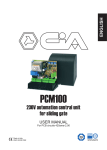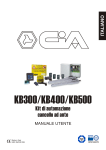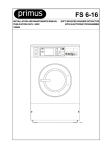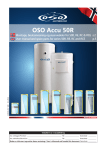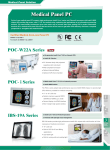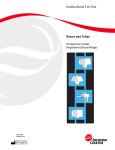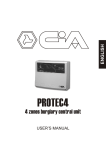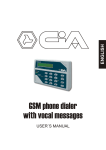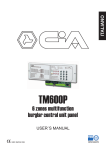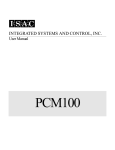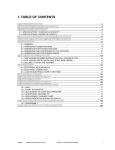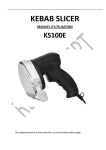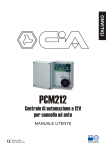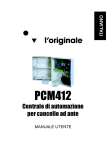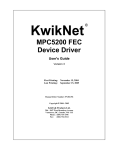Download KS100E / KS200E
Transcript
ITALIANO ENGLISH KS100E / KS200E Automation kit for sliding gate USER MANUAL For PCB circuits 425ama-2.00 Made in Italy EMC 89/336 CEE KS100E / KS200E - User Manual Important Safeguards ! ! ! ! ! ! ! ! ! ! ! ! ! ! ! Please read this manual carefully before the installation and keep it for future reference. Installation, electrical connections and adjustements must comply with technical and safety standards in force. (UNI 8612). HILTRON Srl cannot be held responsible for failure to observe technical standards in the construction of gates, or for any deformation of gates which may occur during the use. This product has been designed and manufactured only for the use stated in this manual. Any other use not expressly set forth will affect the reliability of the product and/or could be source of hazard. HILTRON Srl cannot be held responsible for any damage caused by improper use or different from the use for wich the autamtion system is destined to. Do not use this device in areas subject to explosion: the presence of flammable gas or fumes is a serious hazard. Before carrying out any operations, turn off the system’s main switch. An omnipower switch shall be provided for the installation with an opening distance of the contacts of 3 mm or more. Alternatively, use a 6A thermomagnetic breaker with a multi-pole switching. Ensure that there is a differential switch up-line of the electrical system, with a trip threshold of 0.03A. Check that the earthing plant is in perfect condition and connect it to the metallic parts. Also earth the Yellow/Green wire of the operator. The end-user must avoid any attempt to repair or adjust the automation personally. These operations must be carried out only by qualified personnel. For maintenance operations, use only CIA original spare parts produced by HILTRON Srl. Do not carry out any modifikeptcations to automation components. Packaging materials (plastic, cardboard, etc.) are a potential hazard and must be out of reach of children. The installer must supply all informations regarding manual operation of the system in the event of an emergency and provide the end-user with this manual attached to the product. The automation is fitted with an anti-crush safety system that is a torque control device. In any case, HILTRON Srl suggests the installation of others safety devices, in ® accordance with standards in force, system operating logic and weight and dimension of the gate. The safety devices (i.e.: photocells, DICHIARAZIONE DI CONFORMITA’ pneumatic edges, etc...) protect areas SECONDO LE NORME ISO/IEC GUIDA 22 EN 45014 wherethere is a mechanical movement hazard (i.e.: crushing, entrapment and COSTRUTTORE: HiLTRON S.r.l. cutting). Each installation must be fitted with INDIRIZZO: Via Caserta al Bravo, 218 Napoli at least one flashing light (i.e.: item MARCHIO UTILIZZATO: LAMP12FG) or with at signalling plate (i.e.: item TRG CIA) fixed to the gate. CODICE PRODOTTO: PCM100 HILTRON Srl cannot be held responsible DESCRIZIONE DEL PRODOTTO: CENTRALE DI AUTOMAZIONE PER CANCELLO regarding safety and correct operation of the SCORREVOLE automation in the event that parts other than Il prodotto sopra descritto risulta conforme ai requisiti prescritti nelle seguenti norme: CIA o r i g i n a l p a r ts ( p r o d u c e d b y HILTRON Srl). PROGETTAZIONI E PRODUZIONI ELETTRONICHE ! ! NORMA APPLICATA TITOLO EN50081-1 (1992) NORMA GENERICA DI EMISSIONE Classe della norma generica: domestico, commerciale ed industriale leggero. EN50082-1 (1992) NORMA GENERICA DI IMMUNITA’ Classe della norma generica: domestico, commerciale ed industriale leggero. EN60335-1 (1996) NORMA PER LA SICUREZZA DEGLI APPARECCHI ELETTRICI D'USO DOMESTICO E SIMILARE La conformita' e' stata valutata sulla base di prove eseguite su campione e con allestimento che rispecchia la configurazione funzionale prevista per la sua utilizzazione allestita interamente con prodotti CIA di produzione HiLTRON S.r.l. . Pertanto il prodotto soddisfa i requisiti della direttiva EMC 89/336/CEE e BT 73/23/CEE. Napoli, 17 Marzo 1999 L’ AMMINISTRATORE DELEGATO 2 Index Index Chapter 1 Introduction 4 1.1 Example of installation ......................................................................................4 Chapter 2 2.1 2.2 2.3 2.4 2.5 2.6 2.7 2.8 2.9 Chapter 3 Geared-motor installation 5 Techincal features .............................................................................................5 Prearrangment of the gate ................................................................................6 Anchorage plate ................................................................................................6 Assembly...........................................................................................................7 Assembly of rack (solution A)............................................................................8 Assembly of rack (solution B)............................................................................9 Installation of magnetic limit-stop FCMM ........................................................10 Emercency operation ......................................................................................12 Mechanical clutch adjustment (MS200 only)...................................................12 Central unit installation 13 3.1 Techincal features ...........................................................................................13 3.2 Board description ............................................................................................14 3.3 Connections ....................................................................................................15 3.3.1 Power supply, flasher, geared-motor, controls .....................................16 3.3.2 Relay photocells connection ................................................................17 3.3.3 Photocells with autodiagnosis connection ...........................................17 Chapter 4 Setup 18 4.1 Operating mode ..............................................................................................18 4.1.1 AUTOMATIC FOR PARK operating .....................................................19 4.1.2 AUTOMATIC operating ........................................................................19 4.1.3 STEP-BY-STEP WITH AUTOMATIC RECLOSING operating .............20 4.1.4 MANUAL STEP-BY-STEP WITH STOP operating...............................20 4.2 Electronic clutch adjustment (trimmer A).........................................................21 4.3 Time of pause adjustment (trimmer B) ............................................................21 4.4 Electronic brake / Slowing down (trimmer C) ..................................................21 4.5 Control LEDs...................................................................................................21 4.6 Remote-control receiver setup ........................................................................22 4.7 Remote-control setup......................................................................................23 Chapter 5 Maintenance 24 5.1 Gate .............................................................................................................24 5.2 Fuses .............................................................................................................24 3 KS100E / KS200E - User Manual 1 Introduction 1.1 Kit content and example of installation 7 3 2 5 6 9 8 4 1 10 12 14 11 13 1 MS100 + PCM100 + FCMS 1 MS200 + FCMS 2 PCM100 FX30 / FX40 / FX55 (TX) FX30 / FX40 / FX55 (RX) FX30 / FX40 / FX55 (TX) FX30 / FX40 / FX55 (RX) LAMP230G PULSAR230G BIRD SC1 FCMM FCMM CRP TWIN TRG/EN 3 4 5 6 7 7 8 9 10 11 12 13 14 (KS100E) Geared-motor MS100 with PCM100 central unit and magnetic limit stop sensor FCMS (KS200E) Geared-motor MS200 and magnetic limit stop sensor FCMS (KS200E) PCM100 central unit Transmitting photocell 1 Receiving photocell 1 (not in KS100PSE) Transmitting photocell 2 (not in KS100PSE) Receiving photocell 2 (KS100E) 230Vac electronic flasher (KS100PSE) 230Vac stroboscopic flasher VHF receiver with antenna Key selector Magnetic opening limit stop Magnetic closing limit stop Plastic rack (optional) VHF twin channel radio-control "AUTOMATIC GATE" signalling plate NOTA: Nel caso del kit KS100 è possibile installare la centrale direttamente all'interno del motore MS100. Per il kit KS200 è necessario invece fissare la centrale a muro. 4 Geared-motor installation 2 Geared-motor installation 2.1 Technical features ! ! ! ! ! ! ! ! ! ! ! Mechanical unblocking with key during power supply absence. Mechanics clutch regolable by setscrew wrench (not included) (only MS200) Power supply voltage: 230Vca ±10% 50Hz Normal current absorption: 160W (MS100); 320W (MS200) Geared-motor speed: 42rpm Max torque (daN): 500 Operating temperature: -20°C +55°C Gate max weight: 1000Kg (MS100);1200Kg (MS200) Grado di protezione: IP44 Geared-motorsdimensions(WxHxD): 250x250x150mm(MS100) 195x240x155mm(MS200) Geared-motors weight: 11Kg(MS100); 18Kg(MS200) 250mm(KS100) 240mm(KS200) 3 1 2 250mm (KS100) 195mm (KS200) 150mm (KS100) 155mm (KS200) 200mm 1 2 3 4 5 6 7 Un-locking key Anchorage plate Gate FCMM (magnetic limit-stop) Rack Gate sliding weels Gate sliding lower guide 5 KS100E / KS200E - User Manual 2.2 ! ! ! ! 2.3 Prearrangement of the gate The gate must have a strong and as far possible indeformable structure. The lower guide, that can be made with 50x50x5mm. Angolar or other suitable structurals, must bew perfectly recltilinear and horizontal. The lower sliding wheels, that will preferably have a diametre of 160mm or 200mm according to the gate’s weight and dimensions, must have lubricable or tin ball bearings. The upper guide, that can be made following either the solution A or B must be located so that gate is perfectly vertical. Anchorage plate Introduce the bolts M8x100 the U profile pieces with leg functions, by fastening through the relevant screw nut. Munt the screws with the legs on the fastening plate; the projection of 25mm must be kept as reported in the fig.3a Anchor to the bottm plate by keeping the size of 58.5mm reported inthe fig.3a ! ! ! ! Notes: It is suggested to set the plate at least 2cm above ground level. Arrange plate so that cable through-hole’s position is as shown in the fig.3b Provide fot a plastic flexible sheath with a diametre of at least 20mm to be introduced into the plate itself is perfectly horizontal. Act so that the achoring concrete casting of the plate results compact with the ancorage concrete casting of the plate results compact withthe anchorage one of the lower guide 2,5mm Cable through-hole Gate wing 58,5mm Anchor plate Fig.3b View from top 6 Geared-motor installation 2.4 ! ! ! ! ! Assembly Remove the 4 screw nuts of the fastening bolts. Fix the gate actuator to the anchor by means of 4 screw nuts without blocking them. Pay attention to set the adjustment covers P between the gate actuator and the plate. Slide below the various rack elements positioning them in contact with the gear (Fig. 11b). Withdraw four adjustament covers in order to obtain a good black-lash between rack and gear. Weld once for all the rack support pegs and fix the screw nuts, after having controlled, sliding manually the gate, that the blocklash gear-rack is always the same. Remarks: In order to slide manually the gate is necessary to realease by means of the key the pinion support shaft (refert to instructins Emergency Operation). Important: After assembling screw the plug of oil (Fig. 13) remove the gasket and screw it on (do not tighten). 7 KS100E / KS200E - User Manual 2.5 ! ! Assembly of rack (solution A) Fix the support pegs to each rack element in correspondence of the three slotted holes by means of the relative blocking screws. Pay attention that the position of the support pegs is below the hole (fig. 4a and 4b) Anchor by means of electrowelding the rack support pegs to the gate’s structure following the distance between the head of the rack the teeth and the anchor plate (see fig. 5a and 5b). Remarks: in order to facilitate the correct alignment of the folowing rack elements, it is suggested to set a third a rack element against two following elements, as shown in fig.6. ! 8 Control that the various rack elements are perfectly, aligned.Control that the alignament right line is parallel to the rail in order to do this slide manually the gate and make sure that the distance between the various rack elements and a fix landmark is always the same. If not set suitable shims between pegs and rack. Geared-motor installation 2.6 Assembly of rack (solution B) It’s possible, if you have o a gear motor of your disposal, to perform as follows ! ! ! To fix the gear motor to the anchor plate, position it so that the distance between sprocket and gate is approximately 18mm. (Fig. 7) Fix to each rack element the support pegs in correspondence of the slotted holes paying attention to position them in the mid-area of the slot (Fig. 8). Lean rack element to the sprocket of the gear motor R positioning it as shown in fig.9a. Then weld then central to the gate’s structure, adeguately strenghtened. Slide manually the gate until the pag.x is in correspondence of the gear (Fig. 9b) and then weld the pag.x. Perform the same operation with the pag.x, after having moved it in correspondence of the wheel R. 9 KS100E / KS200E - User Manual 2.7 ! Installation of magnetic limit-stop FCMM Fix the two magnets 1 and 2 on the included brackets by the screw; by unscrewing this screw it will be possible to move the magnet for a final adjustment of the limit-stop. The magnets are polarized in different way and distinguished by the numbers 1 and 2 as in the picture: 1 ! 2 Lock the already assembled brackets (bracket+magnet) on the rack by the provided screws. Magnet 1 10 Magnet 2 Geared-motor installation ! Mounting the provided plastic blocks as shown in picture “A” it will be available an internal space of 12mm for mounting on a steel rack. ! For mounting on a plastic rack of 15mm, mount the plastic block inverted as shown in picture “B”. B A á ! 12mm á 15mm The FCMS sensor inside of the motor has 3 wires, where the BLUE is common, while the two others (WHITE and BLACK), operates as opening/closing relatively to the magnets 1 and 2. 11 KS100E / KS200E - User Manual 2.8 Emergency operation In case of troubles or lack of current, release gate actuator using the appropiate key and acting on the ENGAGEMENT/RELEASE device as follows: Open the line switch. Lift the cover and let it rotate, so as to reach the key-hole. Introduce release key C. Turn apposite clockwise, several times until the gate is released. When emergency situation has ceased, to restore operating conditions, turn the key a few times, counterclockwise, until it stops turning. Slide manually the gate so that the teeth of the frontal clutch, if they are in the particolar postion: head against head, can return to the right position of clutch. Then strongly close the key clockwise again. Close the line switch. ! ! ! ! ! MS100 2.9 MS200 Mechanical clutch adjustment (MS200 only) It's possible to steady the clutch by means of a hexagonal key. + 12 HEXAGONAL KEY Central unit installation 3 Central unit installation PCM100 Central Unit for sliding gates operates a geared-motor 230Vac 700VA max, as MS100 or MS200 producted by CIA, by an electrical clutch, realized with a microprocessor of last generation. PCM100 Central Unit is furnished with a sophisticated circuit of autodiagnosis that controls costantly the operation of the system and connected devices; in case of troubles, the circuit stops all central unit operation. The monitoring of peripheral operating connected to the central unit is displayed by LEDs placed on the circuit. Moreover, PCM100 Central Unit is furnished also with a electrical brake to guard the stop of geared-motor. In place of the brake, the slowing down function is activated 3 seconds before the limit stop to avoid unnecessary impacts during the opening and closing operating. PCM100Central Unit is in accordance with EMC 89/336 directives and 73/23 EEC directives. 3.1 ! ! ! ! ! ! ! ! ! ! ! ! ! ! ! ! ! ! ! ! ! Technical Features SLOWING DOWN function withBRAKE trimmer at minimum. BRAKE function adjustable by trimmer with exclusion at minimum. Programmable operating modes: Automatic, Semiautomatic, step-by-step with automatic reclosing, step-by-step with STOP. Built-in interface for BIRD receiver. TORQUE adjustment by trimmer. Operation Autodiagnosis. Peripheral monitoring by LEDs. Regulation trimmer: BREAK, PAUSE, CROWD FORCE. Total Opening control input. Partial Opening control input. STOP control input. 2 configurable inputs for photocells as IR-SYSTEM with AUTODIAGNOSIS type. External Box in ABS - IP44. Power supply voltage: 230V~ ±10% 50Hz Normal Current Absorption: 6W FCMS Service output voltage: 24V~ ±5% max 0,1A Limit-stop Opening/closing time: max 90 sec. sensor Time of Pause: 4 ÷ 60 sec. Operating Temperatures: -25ºC ÷ 55ºC External box dimensions (WxHxD): 127x138x57mm Board dimensions (WxH): 98x118mm PCM100 central unit installed inside of MS100 motor 13 KS100E / KS200E - User Manual 3.2 Board Description 3 2 4 14 15 8 7 6 5 12 11 10 1 21 16 9 13 18 17 19 20 1 Voltage fuse (250Vac 3,15A) 12 LED closing limit stop status 2 Trimmer A: electronic clutch 13 LED STOP Status 3 Trimmer B: time of pause 14 LED microprocessor diagnosis 4 Trimmer C: electr. brake / slowing down 15 Setup Dip-Switch 5 P1: total opening 16 6 P2: partial opening Opening/closing limit stop connector, to use when central unit is installed inside motor. 17 LED Button P1 230Vac power supply clamps 7 18 LED Button P2 Flasher and motor clamps 8 19 LED photocell 1 status BIRD and commands clamps 9 20 LED photocell 2 status Photocells and 24 Vac clamps 10 21 11 LED opening limit stop status Opening/closing limit stop clamps, to use when central unit is installed outside motor. 14 autoapprendimento codice radiocomando Central unit installation 3.3 Connections 22 21 20 Limit-stop connector 1 2 3 4 5 6 7 8 9 10 11 12 13 14 15 16 17 18 19 Use this connector only if central unit board is installed inside of the gearedmotor. NOTE: If it should be necessary to invert the limit-stop wires, invert the 9 and 10 magnets at page 6. 1 - L1 2 - Ground 3-N POWER SUPPLY 230V~ ±10% 50Hz 4 - Pole 1 5 - Pole 2 6 - Closing 7 - Common (blu wire) 8 - Opening ELECTRONIC FLASHER 230V~ 9 - Pole 1 (clamp 1 BIRD) 10 - Pole 2 (clamp 2 BIRD) BIRD ANTENNA 11 - Common 12 - Pulse STOP (NC) 13 - Pulse A (NO) 14 - Pulse B (NO) COMMANDS 15 - NC 16 - Common 17 - NC 18 - 24V~ max 100mA 19 - 24V~ max 100mA PHOTOCELLS (FX30 - FX40 - FX55) 20 - Opening limit-stop 21 - Limit-stop common 22 - Closing limit-stop LIMIT-STOP Use this clamps only if central unit board is installed outside of the geared-motor. GEARED MOTOR 230V~ 700W max 15 KS100E / KS200E - User Manual 3x1,5mm BIRD ( 8 page 4) N Ground 3x1,5mm L1 2x1mm Power supply, flasher, geared-motor, commands 2x1mm 3.3.1 POWER SUPPLY 230V~ ±10% 50Hz Partial opening 2B Total opening Optional Controls buttons (entry phone, etc.) WARNING: Use a shielded cable with two wires, 2S type, only for the connection of BIRD receiver. Do not use free wire of another devices. We rember you to look out the polarity during the connection. PULSAR230G LAMP230G ( 7 page 4) Flasher 230V~ MS100 ( 1 page 4) 230V~ 700W max STOP NC NO 4S SC1 ( 9 OPEN CLOSE page 4) Closing Common (blu) Opening N.O. 16 Timer To leave the gate opened, it’s possible to connect a timer, as shown above (par.3.2.1), and to set the opening of the gate in a given time. (i.e.: 7:00 ÷ 8:30 a.m.) When the timer is activated (relay contact from NA Normally Open to NC Normally Close), the opening of the gate will stop up to the timer contact will be NC Normally Close. Installation 2.3.2 DIP1 Relay photocells FX40, FX55 ON 5 3 4 2 (3 page 4) 5 3 4 2 (5 page 4) 1 2 (4 page 4) 1 C NA NC 1 2 (2 page 4) 1 C NA NC SW4=OFF 2.3.4 DIP1 Photocells with autodiagnosis FX30 ON 1 2 2 1 1 (4 page 4 2 (2 page 4) 1 2 SW4=ON (3 page 4) (5 page 4) NOTE: If you work with photocell type FX30, you must connect both photocell 1 and photocell 2 . 17 KS100E / KS200E - User Manual 4 Setup 4.1 Operating mode The operating mode and the various options are settable by the switches 1, 2 and 3 of the dip-switch present on the board ( 15 at page 14). The switch 4 can set the installed photocell model (see previous page). Here's a summary of all options: ON Automatic for Park operating OFF OFF Automatic operating ON OFF Step by step with automatic closing OFF ON Step by step with STOP ON ON Locking enabled ON Locking disabled OFF FX30 (autodiagnosis) ON FX40 - FX55 OFF ON Switch 1 and 2: Operating ON ON ON Switch 3: Opening locking on photocells interruption ON ON SWITCH 4: Tipo di fotocellula installata ON To learn about operating logics see next paragraph. ATTENTION: The DIP- SWITCH setting up has to be made with central unit switched off. 18 Setup 4.1.1 AUTOMATIC FOR PARKS operating (SW1=OFF - SW2=OFF) One pulse allows : opening , pause , automatic closing . During the opening operation, other pulses will be ignored. During the closing operation, possible pulses stop and reverse the movement of gate immediately. A contact closed on PULSE A ( Clock function ) allows to open the gate up to the setted pause and it be open up to the opening of the contact. GATE STATUS PULSE A CLOSE Total Opening and reclosing after the time of pause PULSE B STOP Partial Opening and Disables A and B pulses closing operation after and disable opening the time of pause ON PHOTOCELL 1 PHOTOCELL 2 See SWITCH 3 pages 9 and 10 No effect if the opening is started by the PULSE A OPENING PARTIAL OPEN IN PAUSE TOTAL OPEN IN PAUSE Total Opening if the opening is started by the PULSE B Total Opening No Effect No Effect The reclosing is stopped and at the end of the pause it restores other 5 sec. up to the reset Stops operation and switches to STOP mode The reclosing is stopped and at the end of the pause, it restores other 5 sec. up to the reset A total opening is possible. The reclosing is stopped and at the end of the pause, it restores other 5 sec. up to the reset The reclosing is stopped and at the end of the pause, it restores other 5 sec. up to the reset CLOSING The closing is stopped and the gate opens again immediately Stops operation and the gate opens immediately IN STOP Restarts the operating procedure before the STOP (closing or opening) 4.1.2 The pulses A and B will be ignored. The opening or closing operation are locked AUTOMATIC operating ( SW1=ON - SW2=OFF) ON One pulse allows :opening, pause, automatic closing. During opening and closing procedures, every pulse stops and reverse the movement of the gate immediately. During the pause, a pulse recloses the gate immediately. GATE STATUS PULSE A CLOSE Total Opening and reclosing after the time of pause PULSE B STOP Partial Opening and Disables A and B pulses reclosing after the time and disable opening of pause OPENING The gate stops and it recloses immediately. OPEN IN PAUSE The gate recloses immediately CLOSING The gate stops and it opens immediately. IN STOP Restarts the operating procedure before the STOP (closing or opening) PHOTOCELL 1 PHOTOCELL 2 See SWITCH 3 pages 9 and 10 No effect Stops operation and switches to STOP mode The reclosing is stopped and at the end of the pause, it restores other 5 sec. up to the reset Stops operation and the gate opens immediately The pulses A and B will be ignored. The opening or closing operation are locked 19 KS100E / KS200E - User Manual 4.1.3 STEP-BY-STEP WITH AUTOMATIC RECLOSING (SW1=OFF- SW2=ON) ON One pulse allows : opening, pause, automatic closing During opening and closing procedures, every pulse stops and reverse the movement of the gate immediately. During the pause, a pulse recloses the gate immediately. GATE STATUS PULSE A CLOSE Total Opening and reclosing after the time of pause PULSE B Partial Opening and Disables A and B pulses closing operation after and disable opening the time of pause OPENING The opening is stopped and the next pulse recloses the gate OPEN IN PAUSE Recloses the gate immediately CLOSING It is locked and only a new pulse recloses the gate IN STOP Restarts the operating procedure before the STOP (closing or opening) 4.1.4 STOP PHOTOCELL 1 PHOTOCELL 2 See SWITCH 3 pages 9 and 10 No Effect Stops operation and switches to STOP mode The reclosing is stopped and at the end of the pause, it restores other 5 sec. up to the reset Stops operation and the gate opens immediately The pulses A and B will be ignored. The opening or closing operation are locked MANUAL STEP-BY-STEP WITH STOP operating (SW1=ON - SW2=ON) ON One pulses opens; the next pulse stops; the next pulse closes ; the next pulse stops; the next pulse opens, etc . DIP1 20 GATE STATUS PULSE A PULSE B STOP PHOTOCELL 1 PHOTOCELL 2 CLOSE Total Opening Partial Opening Disables A and B pulses and disable opening See SWITCH 3 pages 9 and 10 OPENING The opening is stopped and the next pulse recloses the gate STOP Reverses the movement of the motor CLOSING The closing is stopped and the next pulse opens the gate IN STOP Restarts the operating procedure before the STOP (closing or opening) No Effect Stops operation and switches to STOP mode Pulses A and B are ignored and all movement are locked Stops operation and the gate opens immediately The pulses A and B will be ignored. The opening or closing operation are locked Setup 4.2 Electronic clutch adjustment (trimmer A) This adjustment works on the thrust force of geared-motor: this force must cause the moving of the gate, and it’s closely dependent on the weight of its structure. During the movement, also the gate acquires a thrust force. Under provisions of the law, the adjustment must be made so that the thrust force of the gate is equal to 15Kg; it means that a force equal to 15Kg, in opposition to the movement of the gate, must stop the gate during its movement. To set this adjustment, we suggest you to use an instrument called linear dynamometer. 4.3 Time of pause adjustment (trimmer B) If the central unit is setted on Automatic operating or Automatic operating for Parks, you must adjust the time of pause that must elapse between the end of the opening and the start of the closing of the gate. 4.4 Electronic Brake / Slowing Down (trimmer C) Turned in anticlockwise direction: Electronic brake: disabled Slowing down: enabled at the end of opening / closing Turned in clockwise direction: Electronic brake: Slowing down: 4.5 enabled, reduces the movement after the limit/stop is activated. disabled Control LEDs Here's a summary of the signallings LEDs present on the board (see page 14): LED COLOR 7 green 8 green 9 ON Pulse on input A (total opening) Pulse on input B (partial opening) BLINKING OFF / st/by / st/by red st/by / Photocell 1 engaged 10 red st/by / Photocell 2 engaged 11 red st/by / 12 red st/by / Opening limit-stop engaged Closing limit-stop engaged 13 yellow st/by / STOP command active 14 green Anomaly Normal operating Anomaly 21 KS100E / KS200E - User Manual 4.6 Remote-control receiver setup Visualization of the programmed code ! ! ! Keep pressed P1 and P2 buttons ( 5 and 6 at page 11) for at least 2 seconds and not more than 5 seconds, up to the two LEDs ( 7 and 8 at page 11) light on. Pressing the P1 button it will be displayed the 12-bit code of "A" channel by a sequence of blinkings of the LEDs: ! one blink of LED 7 indicates dip switch ON ! one blink of LED 8 indicates dip switch OFF At the end of the sequence, it will exit automatically the setup mode. NOTE: If no buttons is pressed in 5 seconds, the produre is stopped and no code will be displayed. NOTE: To visualize the code of the “B” channel, repeat the same procedure using the P2 button. Auto-learning of the remote-control code ! ! ! ! Keep pressed P1 and P2 buttons ( 5 and 6 at page 11) for at least 5 seconds up to the two LEDs start to blink ( 7 and 8 at page 11). Press P1 button, only LED 7 starts to blink. During the blinking, within 5 seconds press the "A" button of the remote-control to let acquire the code. The LED 7 starts a sequence of blinkings to indicate that the code has been acquired and it will exit automatically the setup mode. NOTE: If no remote-control is activated in 10 seconds, the setup is stopped and no code will be programmed. NOTE: For the acquisition of the code of the channel "B” of the remote-control, repeat the procedure using P2 buttons and LED 8 . Summary of setup accessing times Time of simultaneous pressure of P1 e P2 buttons: 0 sec. LED Status Function 22 2 sec. 5 sec. LED “1” and “2” turn off LED “1” and “2” light LED “1” and “2” blink No action Release P1 and P2 buttons to enter in Code Display Mode. Release P1 and P2 buttons to enter in Auto-acquisition Code Mode Setup 4.7 Remote-control setup The TWIN allows the independent set-up for each of 2 channels; It’s possible to memorize a different code on each button, and a channel to select (A, B, C, or D) also if they are not on the same code. The set-up operation has to be repeated for each of the 2 buttons of the radiocontrol. In order to start the set-up phase you have to push both the buttons for some seconds, until the LED remains on, then you have to leave them: + For insert a new code you have to access with the following sequence: "1" - "1" - "0" - "0” ! Insert the 10 digit of the code using: ? ? ! During the insert of each code the LED will switch off for some seconds. Insert the 2 digit of the channel using: ! ! ? Channel A "1" - "0": It means the left button for the previous TWIN versions ? Channel B "1" - "1": It means the right button for the previous TWIN versions ? Channel C "0" - "0": to use together with quadri-channels receivers ? Channel D "0" - "1": to use together with quadri-channels receivers Push the button that you want to assign at the code. The LED switch off at the end of the set-up. & * “0” (right button ): It means dip-switch "OFF" for the previous TWIN versions* “1” (left button): It means dip-switch "ON" for the previous TWIN versions* For example, to duplicate the left button (channel A) of a previous TWIN version that has the dip-switch set as following: ON OFF 1 2 3 4 5 6 0 0 1 7 8 9 10 You have to digit the following buttons sequence: 1 + 1 0 0 Access 1 0 0 1 1 0 code 1 1 0 (fast flash of the LED) 1 channel A assigned to left button For read the code you have to digit the following sequence:"1" - "0" - "1" -"0" ! Push on the button that you want to know the code ! The LED switch off and it start one series of 12 flashes: ? A brief flash means "0" ? A long flash means "1” During the set-up, if you don’t push on any button for at least 5 seconds the LED switch off and the setting phase finish automatically. Unscrew the screw on the bottom of the radio-control to open the plastic cover, take off the old battery and insert a new one according with the polarities indicated on the plastic cover. Check the correct operation of the two buttons after to close the plastic cover. 23 KS100E / KS200E - User Manual 5 Maintenance 5.1 Gate It`s suggested to carry out periodic checks on the structure of the gate and in particular it`s suggested to verify verificare the perfect condition of gears, ruck and all mechanical elements. ! ! 5.2 F1 24 Grease periodically the spocket wheel rackwork kinematic system. Chek periodically (at least once every 6 months) the sensibility of the clutch. To perform this operation, act by means of the key on the specific adjustament pawl, so that the operating force, estimated manually on the gate wing, does not exceed a thrust of 7/8kg. Fuses 3,15A 250V VOLTAGE Fuse This fuse allows the protection from overloads of the central unit transformer, from voltage drops of the flasher and of the geared-motor. 272BDE-1.04
























